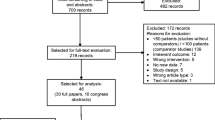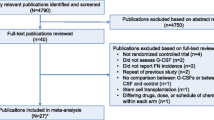Abstract
Recombinant granulocyte colony-stimulating factor (G-CSF) [filgrastim and lenograstim] and pegylated G-CSF (pegfilgrastim) have been shown to reduce the severity and duration of chemotherapy-associated febrile neutropenia (FN) when administered prophylactically to cancer patients receiving chemotherapeutic regimens. The American Society of Clinical Oncology (ASCO) evidence-based clinical guidelines published in 1994, 1996 and 1997 recommended primary prophylaxis with G-CSF for cancer patients. The 2000 ASCO update, with the same recommendation, highlights the importance of economic considerations in decision making for CSFs. This paper reviews the available cost-effectiveness evidence on the use of G-CSF as primary prophylaxis against FN in patients with small cell lung cancer (SCLC).
Cost-effectiveness ratios from a healthcare payer perspective supported the use of filgrastim as primary prophylaxis for people with SCLC, on the basis of both clinical and economic benefits, treated with chemotherapeutic regimens that have an FN rate in the range of 40–60%. However, when indirect and patient out-of-pocket costs attributable to severe FN are included, available evidence suggests that the risk threshold may be reduced by more than half.
Given that FN rates associated with chemotherapeutic regimens for SCLC are generally <40%, then few circumstances would warrant the use of G-CSFs (filgrastim and lenograstim) under the current rule. However, inclusion of indirect costs would lower the cost-effectiveness threshold. Future cost-effectiveness studies of medications such as pegfilgrastim should attempt to capture the societal perspective by incorporating productivity-related costs and using base-case rates of FN reported in the literature.


Similar content being viewed by others
References
Abeloff MD, Armitage JO, Niederhuber JE, et al. Clinical Oncology. 3rd ed. Philadelphia (PA): Elsevier Churchill Livingstone, 2004
Crawford J, Ozer H, Stoller R, et al. Reduction by granulocyte colony-stimulating factor of fever and neutropenia induced by chemotherapy in patients with small-cell lung cancer. N Engl J Med 1991; 325: 164–70
Holmes FA, O’shaughnessy JA, Vukelja S, et al. Blinded, randomized, multicenter study to evaluate single administration pegfilgrastim once per cycle versus daily filgrastim as an adjunct to chemotherapy in patients with high-risk stage II or stage III/IV breast cancer. J Clin Oncol 2002; 20: 727–31
Trillet-Lenoir V, Green J, Manegold C, et al. Recombinant granulocyte colony stimulating factor reduces the infectious complications of cytotoxic chemotherapy. Eur J Cancer 1993; 29A (3): 319–24
ASCO CSF Guideline Expert Panel. Update of recommendations for the use of hematopoietic colony stimulating factors: evidence-based clinical practice guidelines. J Clin Oncol 1996; 14: 1957–60
2000 update of recommendations for the use of hematopoietic colony stimulating factors: evidence-based, clinical practice guidelines. J Clin Oncol 2000 Oct; 18 (20): 3558–85
Messori A, Trippoli S, Tendi E. Filgrastim for the prophylaxis of neutropenic fever in patients with SCLC receiving myelosuppressive antineoplastic chemotherapy: meta-analysis and pharmacoeconomic evaluation. J Clin Pharm Ther 1996; 21: 57–63
Lyman GH, Kuderer N, Greene J, et al. The economics of febrile neutropenia: implications for the use of colony-stimulating factors. Eur J Cancer 1998; 34: 1857–64
Chouaid C, Bassinet L, Fuhrman C, et al. Routine use of granulocyte colony-stimulating factor is not cost-effective and does not increase patient comfort in the treatment of small-cell lung cancer: an analysis using a markov model. J Clin Oncol 1998; 16: 2700–7
Glaspy JA, Bleecker G, Crawford J, et al. The impact of therapy with filgrastim (recombinant granulocyte colony-stimulating factor) on the health care costs associated with cancer chemotherapy. Eur J Cancer 1993; 29A Suppl. 7: S23–30
Nichols CR, Fox EP, Roth BJ, et al. Incidence of neutropenic fever in patients treated with standard-dose combination chemotherapy for small-cell lung cancer and the cost impact of treatment with granulocyte colony-stimulating factor. J Clin Oncol 1994; 12 (6: 1245–50
Drummond M, Davies L. Economic evaluation of lenograstim for prophylaxis of chemotherapy-induced neutropenia in patients with SCLC. Pharmacoeconomics 1994; 6 Suppl. 2: 44–52
US Dept of Labor, Bureau of Labor Statistics [online]. Available from URL: http://www.bls.gov/opub/ted/2002/may/wk3/art04.txt [Accessed 2003 Oct 14]
Heckinger E, Lee J, Calhoun E, et al. Cost-minimization analysis of pegylated filgrastim (pegylated G-CSF) for stage II-IV breast cancer patients receiving chemotherapy: assessment based on third party and societal perspectives. Proc Am Soc Clin Oncol 2003, 2116a
Cosler LE, Calhoun EA, Agboola O, et al. Effects of indirect and additional direct costs on the risk threshold for prophylaxis with colony-stimulating factors in patients at risk for severe neutropenia from cancer chemotherapy. Pharmacotherapy 2004 Apr; 24 (4): 488–94
Weininger R, Mullaly K, Quigley J, et al. Indirect and direct costs associated with a febrile neutropenic event [abstract 2160]. Proc Am Soc Clin Oncol 2003; 22: 537
American Cancer Society. Cancer Facts and Figures. Atlanta (GA), 2003
Use of hematopoietic colony-stimulating factors: evidencebased, practice guidelines. J Clin Oncol 1994; 12: 2471–508
Update of recommendations for the use of hematopoietic colony-stimulating factors: evidence-based clinical practice guidelines. J Clin Oncol 1996 Jun; 14 (6: 1957–60
1997 update of recommendations for the use of hematopoietic colony-stimulating factors: evidence-based, clinical practice guidelines. J Clin Oncol 1997 Oct; 15 (10): 3288
American Society of Clinical Oncology Growth Factors Expert Panel. J Clin Oncol 2000 Oct 15; 18 (20): 3558–85
Bennett CL, Smith TJ, Weeks JC, et al., for the Health Services Research Committee of ASCO. Use of the hematopoietic colony-stimulating factors: the American Society of Clinical Oncology survey. J Clin Oncol 1996; 14 (9): 2511–20
Bennett CL, Bishop MR, Tallman MS, et al. The association between physician reimbursement in the US and use of hematopoietic colony stimulating factors as adjunct therapy for older patients with acute myeloid leukemia: results from the 1997 American Society of Clinical Oncology survey. Ann Oncol 1999 Nov; 10 (11): 1355–9
Adams JR, Lyman GH, Djubegovic B, et al. G-CSF as Prophylaxis of febrile neutropenia in SCLC. Expert Opin Pharmacother 2002; 3 (9): 1273–81
Myeloid growth factors in cancer treatment [online]. Available from URL: http://neen.org/professionals/physician GLSIPDF/myeloid.growth.pdf [Accessed 2005 Jun 27]
Cosler LE, Sivasubramaniam V, Agboola O, et al. Effect of outpatient treatment of febrile neutropenia on the risk thresh-old for the use of CSF in patients with cancer treated with chemotherapy. Value Health 2005 Jan-Feb; 8 (1): 47–52
Lyman GH, Dale DC, Friedberg J, et al. Incidence and predictors of low chemotherapy dose-intensity in aggressive non-hodgkin’s lymphoma: a nationwide study. J Clin Oncol 2004; 22: 4302–11
Bennett CL. Cost analysis of granulocyte colony stimulating factor: a focus on older patients with cancer. Crit Rev Oncol Hematol 2003; 48 Suppl.: S71–4
Gold MR, Siegel JE, Russel LB, et al. Cost-effectiveness in health and medicine. New York: Oxford University Press, 1996
O’Brien BJ, Goeree R, Gnafi A, et al. Assessing the value of a new pharmaceutical: a feasibility study of contingent valuation in managed care. Med Care 1998; 36 (3): 370–84
Acknowledgements
Drs Calhoun and Bennett have received unrestricted grants and consultancy fees from Amgen.
Author information
Authors and Affiliations
Corresponding author
Rights and permissions
About this article
Cite this article
Calhoun, E.A., Schumock, G.T., McKoy, J.M. et al. Granulocyte colony-stimulating factor for chemotherapy-induced neutropenia in patients with small cell lung cancer. Pharmacoeconomics 23, 767–775 (2005). https://doi.org/10.2165/00019053-200523080-00003
Published:
Issue Date:
DOI: https://doi.org/10.2165/00019053-200523080-00003




